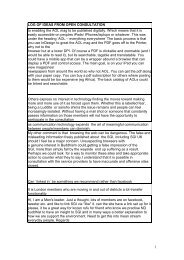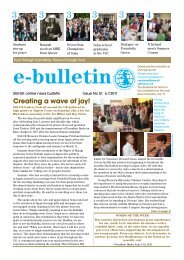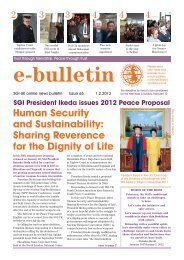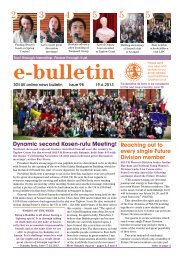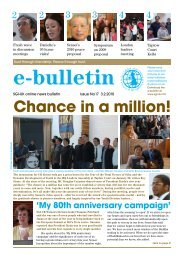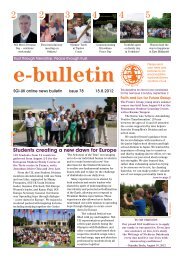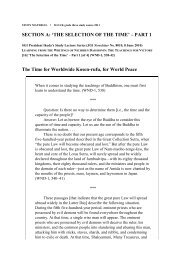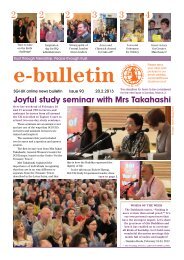History of Buddhism – Notes.pdf
History of Buddhism – Notes.pdf
History of Buddhism – Notes.pdf
You also want an ePaper? Increase the reach of your titles
YUMPU automatically turns print PDFs into web optimized ePapers that Google loves.
Aims <strong>of</strong> the meeting<br />
SGI-UK Study Department<br />
Introductory Study Programme<br />
<strong>History</strong> <strong>of</strong> Nichren <strong>Buddhism</strong><br />
NOTES<br />
For some people, the <strong>Buddhism</strong> <strong>of</strong> Nichiren Daishonin is the first type <strong>of</strong> <strong>Buddhism</strong> that<br />
they encounter; for others it is only through having tried other forms that they come to hear<br />
<strong>of</strong> Nam-myoho-renge-kyo and wish to practise. Nevertheless, most people will have some<br />
concept <strong>of</strong> <strong>Buddhism</strong> that sticks in their mind. This meeting is not intended to explain the<br />
totality <strong>of</strong> <strong>Buddhism</strong> but rather to focus on the links between the <strong>Buddhism</strong> <strong>of</strong> Shakyamuni,<br />
how Nichiren Daishonin established the <strong>Buddhism</strong> for our age, and how members <strong>of</strong> SGI<br />
are making kosen-rufu a reality.<br />
We hope that everyone attending the many meetings that will be taking place around the<br />
country will grasp the following:<br />
To begin to appreciate that there has been a `flow` or transmission over a period <strong>of</strong><br />
3,500 years from Shakyamuni`s Lotus Sutra to the <strong>Buddhism</strong> <strong>of</strong> Nichiren Daishonin<br />
which is expressed through the SGI movement;<br />
Key points in the history <strong>of</strong> the SGI movement for Kosen rufu<br />
Other Materials<br />
There is an excellent English language translation <strong>of</strong> the Lotus Sutra, translated by Burton<br />
Watson, called ‘The Lotus Sutra` and published by Columbia University Press. It is available<br />
from SGI-UK’s bookshop or via local libraries. However it is important to stress how<br />
difficult it is to grasp meaning and significance by reading the text <strong>of</strong> the sutra.<br />
It is probably best to work up to an attempt to read the sutra itself by reading Daisaku<br />
Ikeda’s dialogues on the Lotus Sutra. The SGI-UK bookshop has such dialogues in 4<br />
volumes called ‘The Wisdom <strong>of</strong> the Lotus Sutra’. These dialogues are also available from the<br />
bookshop in 3 volumes called ‘Conversations and Lectures on the Lotus Sutra.’<br />
Daisaku Ikeda has also written an excellent interpretive biography <strong>of</strong> Shakymani. It is called<br />
‘The Living Buddha’ and is published by Weatherhill., also available from the SGI-UK<br />
bookshop or local libraries. However a short but extremely readable account <strong>of</strong> the life <strong>of</strong><br />
Shakyamuni can be found from page 141 <strong>of</strong> volume 3 <strong>of</strong> ‘The New Human Revolution’<br />
(available in the bookshop).<br />
Please encourage the participants to start using the Gosho to find answers to questions on<br />
<strong>Buddhism</strong>.
For example, in On Curing Karmic Disease [WND p633] Nichiren Daishonin gives two quotes<br />
from the Lotus Sutra about its superiority in relation to all the other sutras. And in Reply to<br />
Hishina Goro Taro [WND p158] he likens the Lotus Sutra to the ocean, the sun or the highest<br />
<strong>of</strong> all mountains.<br />
In A Sage and an Unenlightened Man [WND p107] Nichiren Daishonin gives an account <strong>of</strong> the<br />
enlightenment <strong>of</strong> Shakyamuni, why he refrained from teaching the Lotus Sutra for the first<br />
40 years <strong>of</strong> his life, and the significance <strong>of</strong> the second chapter <strong>of</strong> the Lotus Sutra.<br />
In The Selection <strong>of</strong> the Time [WND p543] the Daishonin explains about the middle period <strong>of</strong><br />
the transmission <strong>of</strong> the Buddhist teachings between Shakyamuni and Nichiren Daishonin.<br />
And later in this writing [WND p547] he gives an account <strong>of</strong> how <strong>Buddhism</strong> came to Japan.<br />
There is more about <strong>Buddhism</strong>’s entry into Japan in On Repaying Debts <strong>of</strong> Gratitude [WND<br />
p702].<br />
These extracts are from the leader <strong>of</strong> the Soka Gakkai <strong>of</strong> Japan, Mr Akiya:<br />
“Nichiren Daishonin, the Buddha <strong>of</strong> the Latter Day <strong>of</strong> the Law, declares, “This I will state.<br />
Let the gods forsake me. Let all persecutions assail me. Still I will give my life for the sake <strong>of</strong><br />
the Law. . . . I will be the pillar <strong>of</strong> Japan. I will be the eyes <strong>of</strong> Japan. I will be the great ship <strong>of</strong><br />
Japan. This is my vow, and I will never forsake it!” [WND p280-1]. The first three Soka<br />
Gakkai presidents made the Daishonin’s vow their own and strove to actualize his vision <strong>of</strong><br />
kosen-rufu. In particular, the strides President Ikeda has made toward achieving that goal are<br />
truly without precedent in the history <strong>of</strong> <strong>Buddhism</strong>. The Soka Gakkai is a gathering <strong>of</strong><br />
courageous individuals who have internalized the spirit <strong>of</strong> their mentor and are taking action<br />
with the same determination.” (NL5546)<br />
and<br />
“In all ages and all corners <strong>of</strong> the globe, there have been all manner <strong>of</strong> revolutions. Some<br />
have succeeded and some have failed. What was it that determined their success or failure? It<br />
was whether the movement was supported by the people. Compared with other schools <strong>of</strong><br />
<strong>Buddhism</strong>, the reason the SGI has been able to forge a solid global alliance <strong>of</strong> the people<br />
without precedent in the history <strong>of</strong> <strong>Buddhism</strong> is that we have placed the utmost importance<br />
on life and human existence, society and the family. The SGI district is a castle <strong>of</strong> the Law<br />
for transforming the times; it is a base <strong>of</strong> friendship and trust whose doors remain open to<br />
the community.” (NL4395)<br />
From Daisaku Ikeda’s January 2001 New Years message:<br />
“The SGI at last has begun to illuminate the new century with the brilliance <strong>of</strong> the morning<br />
sun - as a ‘pillar’ <strong>of</strong> peace for humankind, a ‘great ship’ <strong>of</strong> culture linking people around the<br />
world, and the ‘eyes’ <strong>of</strong> education for global citizenship. The global spread <strong>of</strong> our kosen-rufu<br />
movement is an unprecedented achievement in the history <strong>of</strong> <strong>Buddhism</strong>.”






